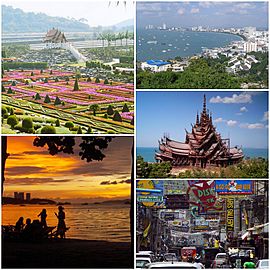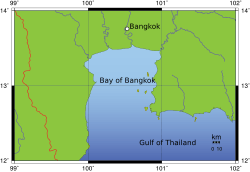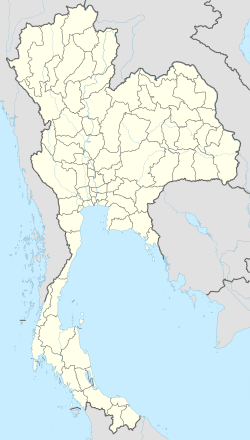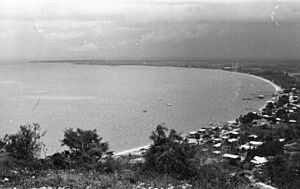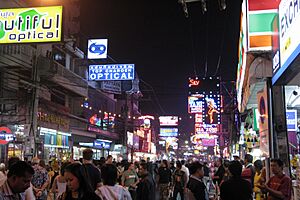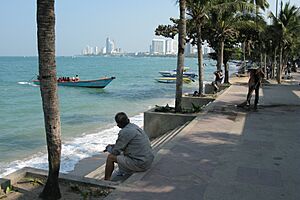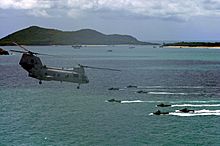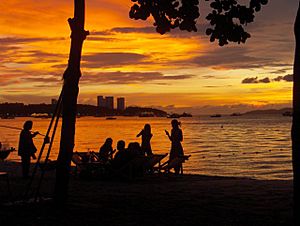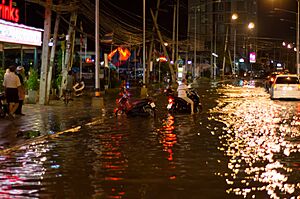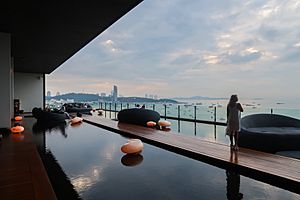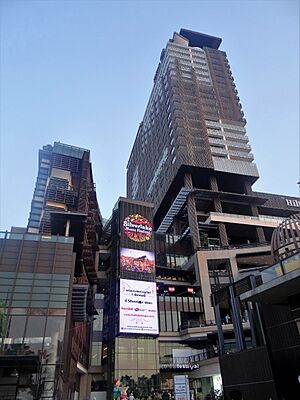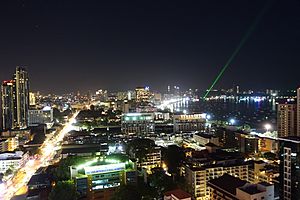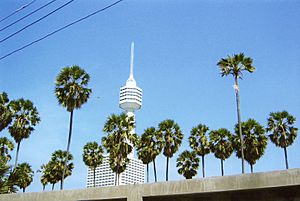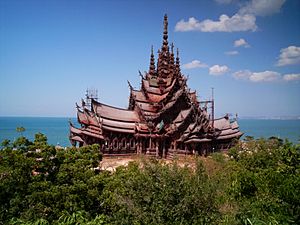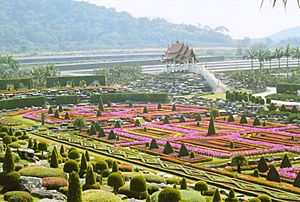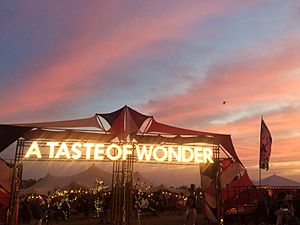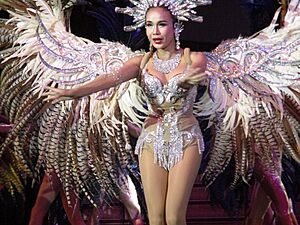Pattaya facts for kids
Quick facts for kids
Pattaya
พัทยา
|
||
|---|---|---|
|
Special governed city
|
||
| Pattaya City เมืองพัทยา |
||
|
From left: Pattaya panorama, Nong Nooch Garden, Pattaya sunset, bird's eye view of Pattaya, The Sanctuary of Truth, Walking Street
|
||
|
||
| Country | Thailand | |
| Province | Chonburi | |
| District | Bang Lamung | |
| Self-administrating municipality | 29 Nov 1978 | |
| Government | ||
| • Type | Special Governed City | |
| Area | ||
| • Special governed city | 53.4 km2 (20.6 sq mi) | |
| • Urban | 727 km2 (281 sq mi) | |
| Area rank | 8th | |
| Population
(2019)
|
||
| • Special governed city | 119,532 (Registered residents) |
|
| • Rank | 10th | |
| • Density | 2,238/km2 (5,800/sq mi) | |
| • Urban | 328,961 | |
| • Metro
(Pattaya-Chonburi Metropolitan Area – Conurbation)
|
999,092 | |
| Time zone | UTC+7 (ICT) | |
| Postcode |
20150
|
|
| Calling code | 038 | |
| ISO 3166-2 | TH-S | |
Pattaya (Thai: พัทยา, RTGS: Phatthaya) is a lively city in Eastern Thailand. It is the second-largest city in Chonburi province and the eighth-largest city in Thailand. Pattaya is located on the east coast of the Gulf of Thailand, about 100 kilometers southeast of Bangkok. In 2021, its urban area had a population of 328,961 people.
Pattaya City is a special local government area within Bang Lamung district. It covers areas like Nong Prue and Na Klua. The city has grown a lot and is now a big part of the "Greater Pattaya" area. It is also part of the "Eastern Seaboard" industrial zone, along with other cities like Si Racha. Pattaya is at the center of the Pattaya-Chonburi Metropolitan Area, which is the third-largest city area in Thailand.
Contents
- Discovering Pattaya's Past
- Pattaya's Climate
- People and Population
- Exploring Pattaya's Geography
- Protecting Pattaya's Environment
- Pattaya's Economy
- Getting Around Pattaya
- How Pattaya is Governed
- Fun Things to Do in Pattaya
- Exciting Festivals in Pattaya
- Media and Communication
- Pattaya in Books and TV Shows
- Learning in Pattaya
- Sister Cities
- See also
Discovering Pattaya's Past
How Pattaya Got Its Name
The name Pattaya comes from a historical event. Back in 1767, before the old capital of Ayutthaya fell to invaders, a leader named King Taksin marched his army through this area. He met a local leader, Nai Klom, who was impressed by King Taksin's army. Nai Klom surrendered peacefully and joined forces with him.
The place where their armies met was called "Thap Phraya," meaning "the army of the Phraya." Later, this name changed to Pattaya. The word Pattaya also means 'the wind that blows from the southwest to the northeast when the rainy season begins'.
Pattaya's Growth and Development

Pattaya was a small fishing village until the 1960s. Its growth as a tourist spot began during the Vietnam War. American soldiers would come here for rest and relaxation. A group of soldiers from a base in Korat visited in 1959. They liked Pattaya so much that they told others, and its fame spread quickly.
The Thai government officially made Pattaya a city on November 29, 1978. It also became a special self-governed city. In 1981, a businessman named Lek Viriyaphan started building the The Sanctuary of Truth. This amazing building is made entirely of wood and is still being built today.
Pattaya in the 21st Century
In 2004, Nirun Wattanasartsaton became Pattaya's first mayor chosen by the people. Later, in 2008, Itthiphol Khunpluem became mayor. After a change in government in 2014, new mayors were appointed. In 2018, Sontaya Kunplome became mayor. His party won the 2022 election, and Poramet Ngampichet has been the mayor since then.
During the COVID-19 pandemic, Pattaya's economy faced challenges because fewer tourists could visit. The city has also had problems with flooding, especially during the monsoon season. In August 2021, heavy rain caused major roads to flood, with water up to two meters deep in some areas. City officials called it the worst flood in a decade.
In November 2023, Pattaya received an award for its honesty and openness. This award was given by the National Anti-Corruption Commission.
Pattaya's Climate
Pattaya has a tropical wet and dry climate. This means it has three main seasons:
- Hot and dry: From December to February.
- Hot and humid: During March and April.
- Hot and rainy: From May to November.
| Climate data for Pattaya (1991–2020) | |||||||||||||
|---|---|---|---|---|---|---|---|---|---|---|---|---|---|
| Month | Jan | Feb | Mar | Apr | May | Jun | Jul | Aug | Sep | Oct | Nov | Dec | Year |
| Record high °C (°F) | 36.0 (96.8) |
37.1 (98.8) |
37.3 (99.1) |
37.0 (98.6) |
36.0 (96.8) |
35.4 (95.7) |
34.9 (94.8) |
34.5 (94.1) |
33.7 (92.7) |
33.8 (92.8) |
35.6 (96.1) |
35.9 (96.6) |
37.3 (99.1) |
| Mean daily maximum °C (°F) | 30.6 (87.1) |
31.2 (88.2) |
32.0 (89.6) |
33.0 (91.4) |
32.7 (90.9) |
32.0 (89.6) |
31.6 (88.9) |
31.4 (88.5) |
31.1 (88.0) |
30.9 (87.6) |
30.8 (87.4) |
30.2 (86.4) |
31.5 (88.6) |
| Daily mean °C (°F) | 26.5 (79.7) |
27.3 (81.1) |
28.3 (82.9) |
29.4 (84.9) |
29.4 (84.9) |
29.0 (84.2) |
28.6 (83.5) |
28.5 (83.3) |
27.9 (82.2) |
27.2 (81.0) |
27.1 (80.8) |
26.4 (79.5) |
28.0 (82.3) |
| Mean daily minimum °C (°F) | 23.5 (74.3) |
24.5 (76.1) |
25.5 (77.9) |
26.4 (79.5) |
26.6 (79.9) |
26.4 (79.5) |
26.2 (79.2) |
26.1 (79.0) |
25.4 (77.7) |
24.7 (76.5) |
24.3 (75.7) |
23.3 (73.9) |
25.2 (77.4) |
| Record low °C (°F) | 16.4 (61.5) |
18.5 (65.3) |
17.7 (63.9) |
20.8 (69.4) |
21.5 (70.7) |
21.3 (70.3) |
21.4 (70.5) |
22.0 (71.6) |
21.5 (70.7) |
19.8 (67.6) |
16.7 (62.1) |
14.6 (58.3) |
14.6 (58.3) |
| Average precipitation mm (inches) | 16.3 (0.64) |
19.9 (0.78) |
47.3 (1.86) |
67.9 (2.67) |
121.1 (4.77) |
132.1 (5.20) |
103.6 (4.08) |
91.2 (3.59) |
213.6 (8.41) |
224.5 (8.84) |
56.6 (2.23) |
11.7 (0.46) |
1,105.8 (43.54) |
| Average precipitation days (≥ 1.0 mm) | 1.6 | 1.8 | 3.3 | 5.0 | 9.0 | 9.8 | 9.5 | 9.1 | 13.2 | 14.4 | 4.0 | 1.5 | 82.2 |
| Average relative humidity (%) | 73.7 | 75.9 | 77.8 | 77.2 | 77.5 | 77.4 | 77.5 | 78.1 | 81.3 | 83.2 | 75.3 | 70.3 | 77.1 |
| Mean monthly sunshine hours | 229.4 | 211.9 | 238.7 | 204.0 | 155.0 | 114.0 | 117.8 | 114.7 | 108.0 | 145.7 | 189.0 | 226.3 | 2,054.5 |
| Mean daily sunshine hours | 7.4 | 7.5 | 7.7 | 6.8 | 5.0 | 3.8 | 3.8 | 3.7 | 3.6 | 4.7 | 6.3 | 7.3 | 5.6 |
| Source 1: World Meteorological Organization | |||||||||||||
| Source 2: Office of Water Management and Hydrology, Royal Irrigation Department (sun 1981–2010)(extremes) | |||||||||||||
People and Population
Pattaya City has about 119,532 registered residents (2019). However, the larger urban area, "Greater Pattaya," has about 328,961 people (2021). Many people who work in Pattaya are not officially counted as residents. This is because they might be migrant workers from other countries or Thai workers who are still registered in their hometowns.
Pattaya is a popular place for foreign retirees to live. The city also has a large Indian community, many of whom speak Tamil.
Exploring Pattaya's Geography
Pattaya is located on the Gulf of Thailand. It is about 160 kilometers south of Bangkok. The city is part of the Bang Lamung District in Chonburi Province.
Pattaya City is a special municipal area. It includes the areas of Nong Prue and Na Kluea, and parts of Huai Yai and Nong Pla Lai. "Greater Pattaya" covers most of the coastline in the Bang Lamung District. It has a northern part with Naklua Beach and Pattaya Beach. To the south is Phra Tamnak Hill, also known as "Buddha Hill" because of its temples. South of Phra Tamnak Hill is Jomtien Beach.
Beaches and Islands of Pattaya
Pattaya Bay has two main beaches. Pattaya Beach runs along the city center for about 2.7 kilometers. It goes from North Pattaya to South Pattaya, which leads to Walking Street. This beach has faced problems with erosion, meaning it has lost sand. A project was started to bring in more sand and make the beach wider.
Phra Tamnak Hill is a great spot for views of Pattaya. It also has a temple called Wat Phra Yai at the top. Pattaya Park and Pattaya Tower are at the south end of this hill. Many people like Phra Tamnak Hill because it feels more natural and has nice beaches.
Jomtien Beach is separated from Pattaya by Thepprasit Road. It has many tall buildings, hotels, shops, and restaurants.
There are also several islands offshore. The "near islands" are Ko Lan (the main island), Ko Sak, and Ko Krok, about 7 kilometers from Pattaya. The "far islands" include Ko Phai (the main island), Ko Man Wichai, Ko Hu Chang, and Ko Klung Badan. These islands are further west.
In 2016, an environmental report said that the sea water near the central Pattaya beaches was not very clean.
Protecting Pattaya's Environment
Pattaya produces about 450 tons of trash every day. The city spends a lot of money each year to remove and dispose of this waste. Sometimes, a lot of trash is also dumped into the sea by tour boats.
In July 2017, Pattaya Beach was polluted for a week because of raw sewage flowing from a storm drain. City officials said this happened because of broken pumps and problems with the sewage treatment plant. The government wants Pattaya to improve its wastewater treatment. There are many sources of pollution in the city, and this number grows as Pattaya gets bigger.
The sea water near central Pattaya beaches has been described as "poor quality." This means it could be harmful to people and sea life. The water quality near other areas like Na Klua, South Pattaya, Ko Lan, and Jomtien Beach is considered "fairly good." The city has thought about making its water treatment plants bigger to handle more wastewater. However, these plans have not been fully put into action.
In 2018, the Pattaya City Council approved money to fix its six wastewater treatment plants. These plants were built in 2000 and can treat 65,000 cubic meters of wastewater daily. More than a third of the equipment was old and worn out.
Pattaya's Economy
Pattaya is a key part of Thailand's "Eastern Economic Corridor" (EEC). This area is getting huge investments for new projects like airports, deep-sea ports, and high-speed railways. These projects will make it much easier to get to Pattaya. Experts believe that these improvements will make Pattaya a major hub in the eastern region. They expect many more tourists to visit the EEC region in the future.
Pattaya also has plans to build a tram system in the city and a larger cruise terminal. New tourist attractions are also being developed, such as a water park, an ice dome, and cultural markets. Officials want to change Pattaya's image to show that it is a place for everyone, with many different attractions. They believe the EEC will help Pattaya compete with other popular beach spots like Phuket and Ko Samui.
In 2018, 14 million visitors came to Pattaya. Tourism brought in a lot of money for the city. Pattaya's leaders want to rely less on tourism in the future. They plan to make Pattaya an international business center, calling it "Neo Pattaya." Important plans include improving flood control and upgrading sewage treatment plants.
Pattaya's real estate market is also very strong. Many foreigners are interested in buying condos here. This helps create jobs in construction and property management. Selling properties also brings in money for the city through taxes.
Recently, there have been many new condo projects in Pattaya. In 2023, Pattaya was the top city in Thailand for condo sales to foreigners, even more than Bangkok.
Getting Around Pattaya
By Road
- You can reach Pattaya from Bangkok using the Bangkok-Chonburi-Pattaya Motorway (Highway 7).
- Another way is the Bang Na-Trat Highway (Highway 34), which connects to Sukhumvit Road (Highway 3).
By Rail
There is a daily train service between Pattaya and Hualumphong Station in Bangkok.
By Bus
Pattaya has bus services from Bangkok's Northern Bus Terminal (Mo Chit) and Eastern Bus Terminal (Ekamai). These buses arrive at Pattaya's main bus terminal on North Pattaya Road.
There are also special bus services to and from Suvarnabhumi Airport (BKK). These buses are modern and air-conditioned. They take about 1.5 hours to reach the airport. Buses from a terminal on Sukhumvit Road connect Pattaya with many places in the north-east region of Thailand.
Within the city, you can travel by songthaew. These are pickup trucks with two rows of seats in the back. People often call them "baht buses" or "blue taxis."
By Air
Pattaya is about 120 kilometers by road from Suvarnabhumi Airport (BKK), Thailand's largest international airport. Pattaya is also served by U-Tapao International Airport (UTP), which is a 45-minute drive south of the city.
By Boat
A ferry service connects Pattaya to Hua Hin. This service started in January 2017. The journey by road takes five to six hours, but the ferry shortens travel time to about two hours. The ferry can carry up to 150 passengers. Larger ferries might be added later.
How Pattaya is Governed
Pattaya city has been run under a special system since October 30, 1978. It is like a municipality and is managed by the mayor of Pattaya city. The mayor is in charge of making plans, providing public services, and overseeing the city's workers. Pattaya covers an area of 53.4 square kilometers and is divided into four subdistricts and 18 villages.
Fun Things to Do in Pattaya
Pattaya was once a small fishing town. It became a popular tourist spot after American soldiers visited during the Vietnam War. In 2018, Pattaya was the 18th most visited city in the world, with 9.6 million tourists. It was the 3rd most visited city in Thailand, after Bangkok and Phuket.
Exciting Festivals in Pattaya
- Chinese New Year: This festival happens in late January or early February. Pattaya's large Thai-Chinese community celebrates with dragon parades, lion dances, and fireworks.
- Pattaya International Music Festival: Held every March, this festival brings huge crowds to stages along Beach Road. It features many types of music from Thai and international artists.
- Pattaya Songkran Festival: Also called Wan Lai, this water festival takes place in mid-April. It lasts longer than other Songkran festivals. Besides water fights, it includes beauty pageants, music, cultural shows, fireworks, and water sports.
- Top of the Gulf Regatta: A week-long sailing event held in late April or early May.
- Miss Tiffany Universe: This beauty pageant is held every mid-May. Transgender models compete for the top prize. The final evening is shown live on Thai TV to millions of viewers.
- Pattaya Marathon: This running event, with different race categories, is held every July.
- Pattaya Classical Guitar Festival: Held annually on the last weekend of October.
- Loi Krathong: This light festival happens during the full moon in November. People float small, candle-lit boats called krathongs on the water. They also release khom loi (candle-fired hot air balloons) into the night sky.
- Miss International Queen: Every November, Pattaya hosts this international pageant for transgender people.
Media and Communication
Pattaya has several local newspapers and magazines published in different languages, such as English, Russian, and German. Some English newspapers include the Pattaya Mail and Pattaya People. The Pattaya News is an online news website that provides local news in six languages.
Pattaya in Books and TV Shows
- The novel Platform by French author Michel Houellebecq features the city of Pattaya and its nightlife.
- The GMMTV series Moonlight Chicken (2023) is set in Pattaya.
Learning in Pattaya
Pattaya has several international schools:
- École francophone de Pattaya
- International School of Chonburi
- Tara Pattana International School
- Rugby School Thailand
- Mooltripakdee International School Pattaya
- Hastin International School
The Thai-Japanese Association School Sriracha, a Japanese international school, is nearby in Si Racha.
Sister Cities
Pattaya has friendly agreements with these cities:
 Shymkent, Kazakhstan (since June 2017)
Shymkent, Kazakhstan (since June 2017) Saint Petersburg, Russia (since June 2017)
Saint Petersburg, Russia (since June 2017) Qingdao, China (since 2013)
Qingdao, China (since 2013) Hubei, China (since 2014)
Hubei, China (since 2014) Zhangjiajie, China (since 2016)
Zhangjiajie, China (since 2016)
See also
 In Spanish: Pattaya para niños
In Spanish: Pattaya para niños



